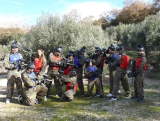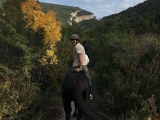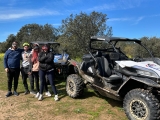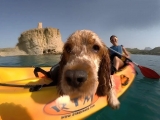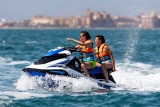
Top diving spots in Mojácar:
Cala Verde (Maximum depth 10m)
This site features the wreck of a pontoon boat that once transported mineral ore from nearby mines for export. During a tremendous storm years ago, the vessel sank and has since become an artificial reef. You'll typically spot conger eels, octopuses, small groupers and occasionally small stingrays.

Las Anclas (Depth 7 to 20m)
This dive site gets its name from the era when large anchors were dropped in this area. The seabed features a massive rock formation just outside Villaricos harbour. The rock slopes gently towards the beach with a small entrance at 18m. The site teems with octopuses, moray eels and large clams.

La Loza 1,2 and 3 (Depth 10 to 30m)
A huge rock formation divided into three dive sites, about 25 minutes from Villaricos harbour. The shallowest part sits at 10m depth, gradually descending to 22m on the northern side. The southern face drops abruptly to a maximum depth of 30m.
Divers can observe a great variety of fish including barracuda, tuna, octopus, moray eels, conger eels and if you're particularly lucky, stingrays.

This dive allows you to descend to 28-30 metres where you'll find an underwater cave in the rocky section that leads back up to 12 metres.
El Calón 1 and 2 (Depth 10 to 25m)
Located about 25 minutes by boat from Villaricos harbour, this site features a massive rock formation with its top at 10m depth. The northern side slopes gently to 20m while the southern face drops to 25m. The marine life includes moray eels, octopuses, groupers...

La Catedral (Advanced Level)
The Cathedral lies about 3km from the fishing village of Villaricos.
This solitary rock formation rises from a depth of 30m. On the southern side of the Cathedral there's a 3×4m opening allowing access to the interior. The walls and ceiling of the cave are covered with various types of coral and sponges. The floor consists of fine coral, so divers must take care not to kick it up and reduce visibility.

Scorpionfish and moray eels have made this cave their home (though sightings aren't guaranteed). In the cave's centre is a stone block placed there years ago by divers.
The exit is through the left side of the cave, while the right side has small openings where fish like to gather. After exiting, divers ascend along the rock wall where morays and octopuses can be spotted.
Parts of the rock are porous, creating a curtain of ascending bubbles from the rock's peak - these are bubbles exhaled by previous divers in the cavity.





